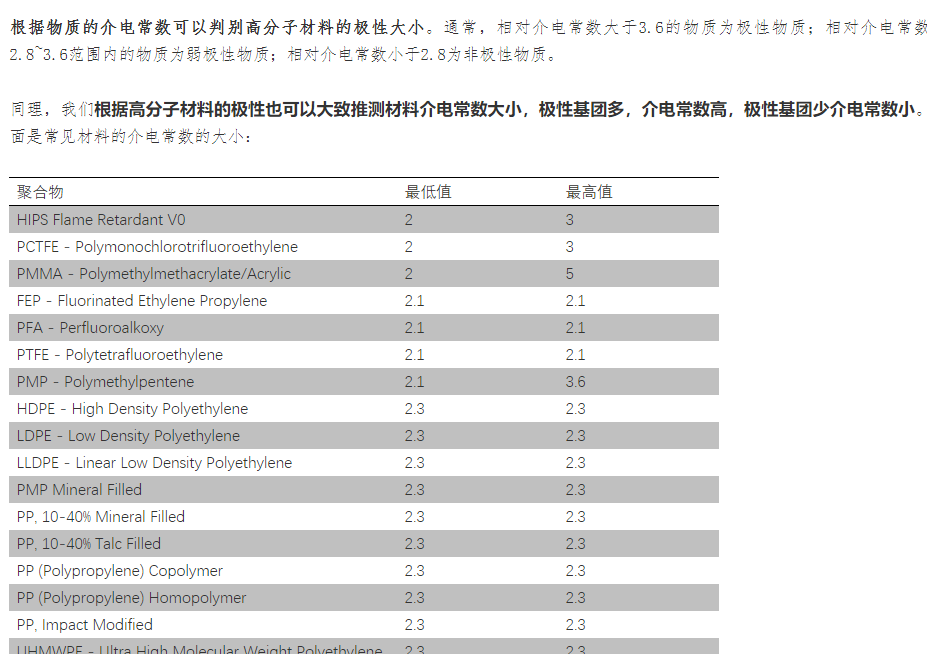工作时间:
联系人:张经理
联系电话:18118113133
发布日期:2020/1/3 13:15:05 访问次数:2868
5G时代信号的传输速度也会远快于4G信号,就要求材料对信号的干扰小、介电常数小,保证大数据传输不受干扰。那么什么是介电常数,各种材料的介电常数又是多少?介质在外加电场时会产生感应电荷而削弱电场,介质中的电场减小与原外加电场(真空中)的比值即为相对介电常数(relative permittivity或dielectric constant),又称诱电率,与频率相关。介电常数是相对介电常数与真空中绝对介电常数乘积。如果有高介电常数的材料放在电场中,电场的强度会在电介质内有可观的下降。理想导体(金属)的相对介电常数为无穷大。
根据物质的介电常数可以判别高分子材料的极性大小。通常,相对介电常数大于3.6的物质为极性物质;相对介电常数在2.8~3.6范围内的物质为弱极性物质;相对介电常数小于2.8为非极性物质。
同理,我们根据高分子材料的极性也可以大致推测材料介电常数大小,极性基团多,介电常数高,极性基团少介电常数小。下面是常见材料的介电常数的大小:
聚合物
最低值
最高值
HIPS Flame Retardant V0
2
3
PCTFE - Polymonochlorotrifluoroethylene
2
3
PMMA - Polymethylmethacrylate/Acrylic
2
5
FEP - Fluorinated Ethylene Propylene
2.1
2.1
PFA - Perfluoroalkoxy
2.1
2.1
PTFE - Polytetrafluoroethylene
2.1
2.1
PMP - Polymethylpentene
2.1
3.6
HDPE - High Density Polyethylene
2.3
2.3
LDPE - Low Density Polyethylene
2.3
2.3
LLDPE - Linear Low Density Polyethylene
2.3
2.3
PMP Mineral Filled
2.3
2.3
PP, 10-40% Mineral Filled
2.3
2.3
PP, 10-40% Talc Filled
2.3
2.3
PP (Polypropylene) Copolymer
2.3
2.3
PP (Polypropylene) Homopolymer
2.3
2.3
PP, Impact Modified
2.3
2.3
UHMWPE - Ultra High Molecular Weight Polyethylene
2.3
2.3
PMP 30% Glass Fiber-reinforced
2.4
2.4
PS (Polystyrene) Crystal
2.4
2.7
PS, High Heat
2.4
2.7
HIPS - High Impact Polystyrene
2.4
4.8
ABS High Heat
2.4
5
ABS High Impact
2.4
5
PS (Polystyrene) 30% glass fiber
2.5
2.5
EVA - Ethylene Vinyl Acetate
2.5
3
SAN - Styrene Acrylonitrile
2.5
3.4
ECTFE
2.57
2.59
ETFE - Ethylene Tetrafluoroethylene
2.6
2.6
PP - Polypropylene 10-20% Glass Fiber
2.6
2.6
PP, 30-40% Glass Fiber-reinforced
2.6
2.6
PPE - Polyphenylene Ether
2.7
2.7
PPE, Flame Retardant
2.7
2.7
PE - Polyethylene 30% Glass Fiber
2.7
2.8
ABS - Acrylonitrile Butadiene Styrene
2.7
3.2
SMA - Styrene Maleic Anhydride
2.8
2.8
ABS Flame Retardant
2.8
3
MABS - Transparent Acrylonitrile Butadiene Styrene
2.8
3
PC - Polycarbonate, high heat
2.8
3.8
PPE, 30% Glass Fiber-reinforced
2.9
2.9
ABS/PC Blend - Acrylonitrile Butadiene Styrene/Polycarbonate Blend
2.9
3.2
PMMA (Acrylic) Impact Modified
2.9
3.7
PBT - Polybutylene Terephthalate
2.9
4
PA 66, Impact Modified
2.9
5
PC/PBT Blend - Polycarbonate/Polybutylene Terephthalate Blend
2.95
3.14
PTFE, 25% Glass Fiber-reinforced
3
3
PSU - Polysulfone
3
3.2
PPS - Polyphenylene Sulfide
3
3.3
ASA/PC Blend - Acrylonitrile Styrene Acrylate/Polycarbonate Blend
3
3.4
PC (Polycarbonate) 20-40% Glass Fiber
3
3.5
PC (Polycarbonate) 20-40% Glass Fiber Flame Retardant
3
3.8
CP - Cellulose Proprionate
3
4
LCP Glass Fiber-reinforced
3
4
PA 6-10 - Polyamide 6-10
3
4
PBT, 30% Glass Fiber
3
4
PEI, 30% Glass Fiber-reinforced
3
4
PEI, Mineral Filled
3
4
PET - Polyethylene Terephtalate
3
4
PET, 30% Glass Fiber-reinforced
3
4
PETG - Polyethylene Terephtalate Glycol
3
4
POM (Acetal) Low Friction
3
4
PVC Rigid
3
4
PVC, Plasticized
3
5
PVC, Plasticized Filled
3
5
LCP Mineral-filled
3
5.9
CPVC - Chlorinated Polyvinyl Chloride
3
6
PVDC - Polyvinylidene Chloride
3
6
CAB - Cellulose Acetate Butyrate
3
7
CA - Cellulose Acetate
3
8
PA 11, Conductive
3
9
PA 11, Flexible
3
9
PA 11, Rigid
3
9
PA 12 (Polyamide 12), Conductive
3
9
PA 12, Fiber-reinforced
3
9
PA 12, Flexible
3
9
PA 12, Glass Filled
3
9
PA 12, Rigid
3
9
SRP - Self-reinforced Polyphenylene
3.1
3.1
ABS/PC Blend 20% Glass Fiber
3.1
3.2
PEI - Polyetherimide
3.1
3.2
PI - Polyimide
3.1
3.55
ASA/PC Flame Retardant
3.2
3.2
PEEK - Polyetheretherketone
3.2
3.2
SMMA - Styrene Methyl Methacrylate
3.2
3.2
PEEK 30% Carbon Fiber-reinforced
3.2
3.4
SAN, 20% Glass Fiber-reinforced
3.2
3.8
PMMA (Acrylic) High Heat
3.2
4
LCP - Liquid Crystal Polymer
3.3
3.3
PAR - Polyarylate
3.3
3.3
PEKK (Polyetherketoneketone), Low Cristallinity Grade
3.3
3.3
SMA, 20% Glass Fiber-reinforced
3.3
3.3
ASA - Acrylonitrile Styrene Acrylate
3.3
3.8
PPS, 20-30% Glass Fiber-reinforced
3.3
3.8
PC/PBT blend, Glass Filled
3.3
3.9
PEEK 30% Glass Fiber-reinforced
3.3
4.2
POM - Polyoxymethylene (Acetal)
3.3
4.7
PPSU - Polyphenylene Sulfone
3.4
3.5
PA 46 - Polyamide 46
3.4
3.8
PA 66, Impact Modified, 15-30% Glass Fiber
3.4
4.2
Amorphous TPI Blend, Ultra-high heat, Chemical Resistant (Standard Flow)
3.5
3.5
PESU - Polyethersulfone
3.5
4.1
PA 66, 30% Glass Fiber
3.5
5.6
PSU, 30% Glass finer-reinforced
3.6
3.7
PPA, 33% Glass Fiber-reinforced – High Flow
3.7
3.9
PARA (Polyarylamide), 30-60% glass fiber
3.9
4.5
PAI - Polyamide-Imide
3.9
7.3
PPS, 40% Glass Fiber-reinforced
4
4
PPA, 30% Mineral-filled
4
4.2
POM (Acetal) Impact Modified
4
4.3
PA 46, 30% Glass Fiber
4
4.6
PA 6 - Polyamide 6
4
5
PA 66 - Polyamide 6-6
4
5
PA 66, 30% Mineral filled
4
5
PESU 10-30% glass fiber
4.2
4.3
PAI, 30% Glass Fiber
4.2
6.5
PPA - Polyphthalamide
4.3
4.3
PPA, 33% Glass Fiber-reinforced
4.4
4.6
PPA, 45% Glass Fiber-reinforced
4.4
4.6
PA 11 - (Polyamide 11) 30% Glass fiber reinforced
4.8
4.8
EVOH - Ethylene Vinyl Alcohol
4.8
5.6
PPS, Glass fiber & Mineral-filled
5
5
PVDF - Polyvinylidene Fluoride
6
9
目前大家探讨比较多是5G工程塑料,主要分为薄膜产品(LCP,PI等用在线路板,天线)、还有就是结构件(注塑成型),如低介电LCP、PBT、PPO、PPS等。选材中既要满足介电常数低又要满足力学性能、化学性能、电性能等因素。改性塑料的介电常数跟基材的分子结构有关,同时也跟增强/填充材料的介电常数有关。
手机浏览不到完整的表格,可以使用电脑查看

上一信息:口罩过滤熔喷PP无纺布技术标准
下一信息:一招教你解决阻燃PP材料析出性问题